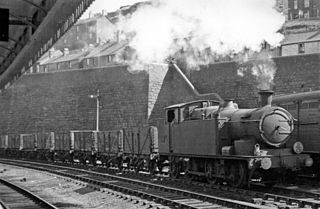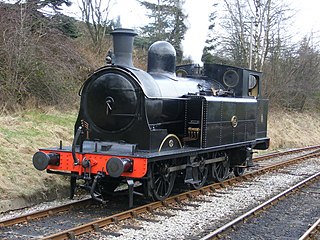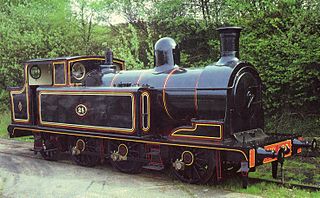
The Taff Vale Railway (TVR) was a standard gauge railway in South Wales, built by the Taff Vale Railway Company to serve the iron and coal industries around Merthyr Tydfil and to connect them with docks in Cardiff. It was opened in stages in 1840 and 1841.
The Rhymney Railway was a railway company in South Wales, founded to transport minerals and materials to and from collieries and ironworks in the Rhymney Valley of South Wales, and to docks in Cardiff. It opened a main line in 1858, and a limited passenger service was operated in addition.

The GWR 5600 Class is a class of 0-6-2T steam locomotive built between 1924 and 1928. They were designed by C.B Collett for the Great Western Railway (GWR), and were introduced into traffic in 1924. After the 1923 grouping, Swindon inherited a large and variable collection of locomotives from historic Welsh railway companies, which did not fit into their standardisation programme. GWR boiler inspectors arrived en masse and either condemned the original locomotives or had them rebuilt. The systematic destruction of many examples of locomotives, most still in serviceable condition, followed, but various were worked alongside 5600 Class.

Pontyclun railway station is an unstaffed, minor railway station in Pontyclun, in the County Borough of Rhondda Cynon Taf, South Wales. The station is at street level, on Station Approach, Pontyclun. It is a stop on the South Wales Main Line, served by trains on the Maesteg Line, and occasionally by the Swanline Cardiff to Swansea regional services, as well as one early-morning daily service to Manchester and a late-night daily service to Carmarthen. The station and all trains are operated by Transport for Wales Rail.

The Barry Railway Company was a railway and docks company in South Wales, first incorporated as the Barry Dock and Railway Company in 1884. It arose out of frustration among Rhondda coal owners at congestion and high charges at Cardiff Docks as well the monopoly held by the Taff Vale Railway in transporting coal from the Rhondda. In addition, the Taff Vale did not have the required capacity for the mineral traffic using the route, leading to lengthy delays in getting to Cardiff.
The Vale of Neath Railway (VoNR) was a broad gauge railway company, that built a line from Merthyr Tydfil and Aberdare to Neath, in Wales, chiefly to transport the products of the Merthyr iron industries to ports on Swansea Bay.
The Taff Vale Railway U and U1 classes were 0-6-2T steam tank locomotive operated by Taff Vale Railway, Wales, from 1895. All were still in use when the Taff Vale Railway was acquired by the Great Western Railway in 1922, but were withdrawn from traffic between 1927 and 1931.

The Rhymney Railway M class was a class of 0-6-2T tank locomotive introduced into traffic on the Rhymney Railway in 1904. These were substantial sized tank engines, and weighed 66 long tons and were 36 feet 9 inches (11.20 m) in length.
The Rhymney R class was a class of 0-6-2T steam locomotive introduced into traffic in 1907 designed by the railway's engineer Hurry Riches. These were substantial sized tank locomotives, and weighed 67 long tons and were 37 feet (11.28 m) in length.

The Rhymney Railway A class were 0-6-2T tank locomotives introduced into traffic in 1910 and designed by the railway's engineer Hurry Riches. These were substantial sized tank engines, and weighed 64 long tons and were 35 ft 9 in (10.90 m) in length.
This Stephenson Class were eleven 0-6-2T locomotives introduced into traffic in 1898 designed and built by Robert Stephenson and Company for the Port Talbot Railway. They predated the somewhat similar but larger Rhymney M class by six years.

The Taff Vale Railway A class was a class of 0-6-2T steam tank locomotives designed by J. Cameron for mixed traffic work and introduced to the Taff Vale Railway (TVR) in 1914. The A class was an enlarged version of the TVR O4 class designed by Tom Hurry Riches in 1907. The A class was the last new class of locomotive to be introduced on the TVR, which had introduced its first 0-6-2Ts in 1885 ; and, with a total of 58 built, was numerically the largest class of tank locomotive on the TVR.

The Taff Vale Railway O4 class was a class of 0-6-2T steam tank locomotives designed by Tom Hurry Riches and introduced to the Taff Vale Railway in 1907. They were rebuilt with taper boilers and superheaters by the Great Western Railway (GWR) from 1924.

The Ely Valley Railway (EVR) was a broad gauge railway company in South Wales, which opened a mineral line between Llantrisant station on the South Wales Railway main line and pits at Mwyndy and Penrhiwfer in 1860.

The Taff Vale Railway O2 class was a class of 0-6-2T steam tank locomotives designed by Tom Hurry Riches and introduced to the Taff Vale Railway in 1899.

The Taff Vale Railway O1 class was a class of 0-6-2T steam tank locomotives designed by Tom Hurry Riches and introduced to the Taff Vale Railway in 1894.
Barry Railway Class C were originally 2-4-0T steam locomotives of the Barry Railway in South Wales. They were designed by J. H. Hosgood and built by Sharp Stewart.
West Yard Works was the Taff Vale Railway's locomotive repair and construction factory. It was located in Cardiff between Bute Street and the Glamorganshire Canal.
The Taff Vale Railway H class was a class of 3 0-6-0T steam tank locomotives designed by Tom Hurry Riches, built by Kitson & Co. and introduced to the Taff Vale Railway in 1884. They were primarily used on the Pwllyrhebog Colliery Incline, and had special tapered boilers for this purpose.

Lambton Colliery Railway No. 29 is a preserved 0-6-2 steam tank locomotive built by Kitson and Company for the Lambton Colliery network in 1904. It was the first 0-6-2T to be employed on that system and was later joined by No. 5. No. 29 was designed to work between Philadelphia and Sunderland. In February 1969, just over 8 months after the end of mainline steam running on British Railways had ceased, and No. 29 was withdrawn from service. In 1970, No. 29 was purchased by volunteers from the North Yorkshire Moors Railway and it was restored to working order. Ever since then, the locomotive has been operating on the NYMR, it is still operational as of 2022.











